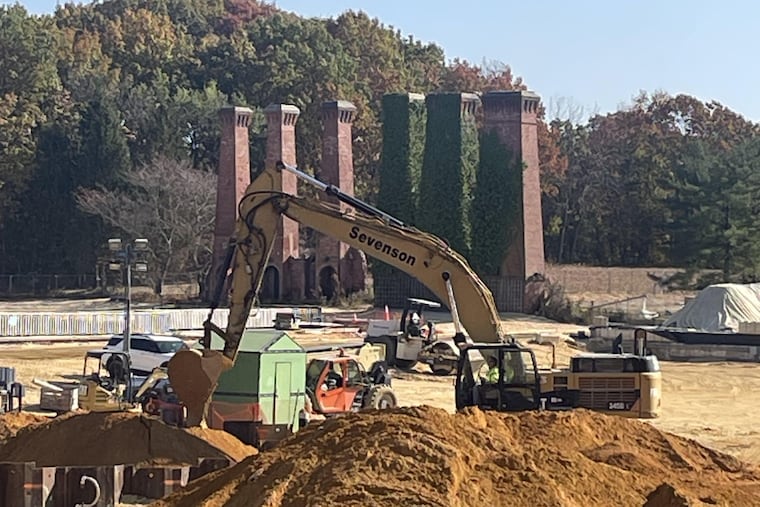A Camden County factory town gears up for redevelopment of Superfund sites
Paint and varnish were produced for 150 years in Gibbsboro in Camden County, where cleanups of three Superfund sites are either complete or underway — and raising hopes for major redevelopment.

Innovative paint manufacturer John Lucas is said to have sampled rivers and streams throughout the Eastern United States before discovering the “pure soft water” he sought — in Gibbsboro, Camden County.
“He supposedly said it was the best water for colors,” borough Mayor Ed Campbell said.
The sprawling factory that grew from the business Lucas established on Hilliards Creek in 1852 became a major source of high-quality paint and varnish, employing hundreds of local residents for generations.
Lucas’ business merged with Sherwin-Williams in 1930, ceased production in 1977, and left behind lead, arsenic, and a host of other toxins in the surface and groundwater, in the surrounding soil — including on residential properties — and in the sediments of the creek and the lakes downstream.
The U.S. Environmental Protection Agency eventually designated three separate tracts as Superfund sites as a result of the pollution.
The remediation progress, begun in 2016 in the 2.2-square-mile borough of 2,200 people, is boosting the prospects for a $100 million privately financed redevelopment project, the mayor said.
“We’re a microcosm of what happened when the Industrial Age ended,” Campbell said. “The factory in Gibbsboro died. But we’re going to bring the borough back.”
The development would include a total of 167 townhouses the borough has approved to be built by the D.R. Horton company on two sites that did not require remediation; three restaurant locations overlooking the lake; a new park; and other amenities.
“It’s a great day for Gibbsboro,” Campbell said Wednesday, standing in front of the house John Lucas built in 1856 on Clementon Road.
The house is uphill from a 20-acre expanse of the former paint works property where crews began to dig up and remove contaminated soil on Aug. 30. Campbell said he expects the site to be “totally remediated” next year.
U.S. Rep. Donald Norcross (D., N.J.) presented the mayor with a symbolic $750,000 check Wednesday for a federal Community Project Funding grant. The money will go toward renovating the Lucas house for public and private use.
The goal “is to transform the house into a community event space that generates revenue,” Norcross said.
Campbell called the grant “important to the future economic development” of Gibbsboro. He said the demolition of the factory and the presence of Superfund sites had “destroyed” the borough’s commercial tax base.
“Superfund activity in Gibbsboro really was stalled, and with the congressman and Camden County Commissioner Jeff Nash, we formed an alliance,” the mayor said. The officials pressured the N.J. Department of Environmental Protection and the EPA to move forward.
“We are now in a much better place where all of the parties are working together,” Norcross said.
Reclaiming an asset that became a liability
South Jersey homebuilder Robert K. Scarborough bought the paint works site for $800,000 in 1981 and planned to spend $2.5 million to redevelop it for commercial use.
“Our first idea was to develop the Paint Works as a warehousing and light industrial park,” he told The Inquirer in 1982. “But as we began to discover what a beautiful setting we have, we gradually shifted more toward an office center.”
A promenade at Silver Lake — giving walkers a good look at a the row of brick smokestacks that still stands — was constructed, as was a large single-story office building at the corner of Clementon Road and Foster Avenue.
But continued state and federal monitoring determined that contamination of the ground and the water was more extensive than previously known. Scarborough died in 2011, and in 2023, the office buildings at Foster and Clementon were demolished.
Visible progress
Remediation at two of the three Gibbsboro Superfund sites — on Route 561 and on United States Avenue — has been completed at a total cost of $22.9 million. Environmental monitoring continues at both.
Projected costs for the cleanup of the factory site and its surroundings include $14.2 million for residential properties and $31.8 million for soil and sediment removal.
And the projected cost for the future remediation of Silver Lake and contaminated bodies of water downstream, such as Bridgewood and Kirkwood Lakes and Hilliards Creek, is $86.4 million, said Stephen McBay, senior press officer with EPA’s Region 2.
He said Sherwin-Williams is paying these costs up front and will reimburse the EPA for its cleanup oversight. Active remediation is expected to continue for several more years.
A trail map to the future
Growing up in Gibbsboro, Campbell, 65, a retired engineer, worked at the paint works factory one summer and remembers when it was an old-fashioned company town.
Today, he is proud of the growth of the borough’s 10 miles of walking, hiking, and biking trails. Some additions to the network are being paid for by Sherwin-Williams. New developers will be asked to link their properties to the trails, and Horton has agreed to do the same with its new townhouses.
Given the popularity of its Blueberry Hill hiking area, Campbell said, he expects ecotourism could offer an economic boost.
And he’d like to see decorative lighting on that set of six brick stacks as well.